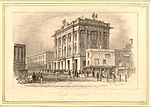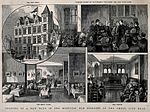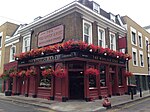Stadthaus

Stadthaus is a nine-storey residential building in Hackney, London. At nine stories (30 meters/98 feet), it is thought to be the second tallest timber residential structure in the world, after the Forte apartment complex in Melbourne, Australia. It was designed in collaboration between architects Waugh Thistleton, structural engineers Techniker, and timber panel manufacturer KLH.Stadthaus is the first high-density housing building to be built from pre-fabricated cross-laminated timber panels. It is the first building in the world of this height to construct not only load-bearing walls and floor slabs but also stair and lift cores entirely from timber.
Excerpt from the Wikipedia article Stadthaus (License: CC BY-SA 3.0, Authors, Images).Stadthaus
Provost Street, London Hoxton (London Borough of Hackney)
Geographical coordinates (GPS) Address Nearby Places Show on map
Geographical coordinates (GPS)
| Latitude | Longitude |
|---|---|
| N 51.5308 ° | E -0.0894 ° |
Address
Graphite Apartments
Provost Street 51
N1 7FB London, Hoxton (London Borough of Hackney)
England, United Kingdom
Open on Google Maps









